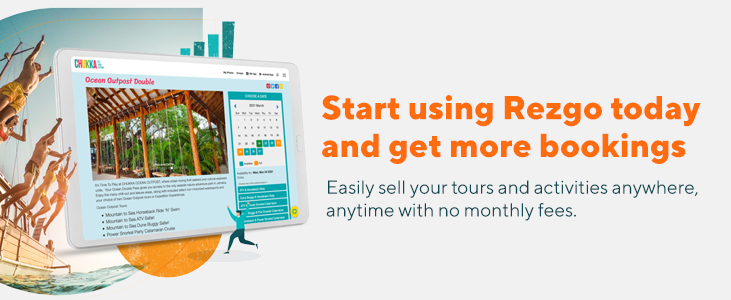Table of Contents
Artificial intelligence (AI) has made waves in the past year and for a good reason. Tools like ChatGPT are rapidly changing industries — including the tour industry.
For a quick explainer, AI is when a computer program can learn and perform certain tasks like humans. Generative AI is when a computer program uses AI to generate new content. That could be text, images, code, audio, or video.
In real terms, you can turn to generative AI to create new blog posts, marketing images, or responses to frequently asked questions. It can save you time and money, so you focus on other parts of your business.
But the prompts you give an AI tool — aka the instructions you give it — can make or break how well an AI tool will perform.
Luckily, it’s a skill you can learn. Below, we’ll cover how to craft effective AI prompts to harness the power of AI in your tour business.
What Are AI Prompts?

First up, what even is an AI prompt? In simple terms, an AI prompt is the instruction you give an AI tool.
In your prompt, you’ll outline what you want the tool to do for you. You can ask a simple question or give a much more detailed set of instructions.
In most cases, the more detailed your prompt, the better the response.
Generative AI is still a fairly new technology and it can make mistakes or return generic, low-quality outputs. Giving AI tools the right prompts can help you overcome some of these challenges.
Creating effective AI prompts is so important that there are even entire jobs revolved around it — this is known as prompt engineering. But you don’t need to hire or become a prompt engineer to write successful AI prompts.
Crafting Effective AI Prompts
Here’s what to keep in mind when crafting an AI prompt.
Provide Plenty of Details

Think of an AI tool like a junior employee. If you give them a vague or easy-to-misunderstand instruction, they probably won’t perform their best.
On the other hand, if you give them a detailed set of instructions and all the information they need to complete a task, they can work their magic.
For example, consider these two prompts:
- Write me a tour description about a brewery tour in Portland.
- Write me a 100-word tour description about a brewery tour in Portland. The tour is three hours long and includes four different breweries. Guests will get a tour of each brewery and taste three different beers in each one. They’ll learn how beer is made, what local ingredients are used, and get a free glass to take home. Please write the tour description in casual language and include bullet points for the key points.
Which one do you think would help a junior employee do their best work?
You might get a half-decent response to the first prompt, but the second prompt will get you much closer to a polished description you can use without too much tweaking. The same goes for AI.
You can also include examples of the kind of tone you’re looking for or certain things to avoid.
The same advice applies when creating AI-generated images.
“Generate a photograph of a person kayaking on a lake with mountains in the background. Use bright colours and a realistic style” will get you a very different image than “kayak.”
Top tip: Rezgo’s Smart Tour Descriptions uses ChatGPT to generate marketing-friendly tour descriptions. You can generate these descriptions with a click of a button as you’re uploading your tours.
Tell AI Who to Act Like

As part of your prompt, you can tell an AI tool who to act like.
For example:
- Pretend you’re a social media manager at a small tour company. You’re in charge of creating a social media strategy, images, and copy.
- Act like you’re a business coach for a small wine-tasting company. Go through these customer reviews and give me a list of common themes and ideas for how I can improve my business.
- You’re a customer service representative for a whale-watching tour operator. You’re going to write answers to common customer questions as if you were answering customer emails.
AI will then give you responses with this point of view in mind, making the outputs much more useful.
Harness Custom Instructions

If you’re using ChatGPT, make the most of custom instructions. This feature is available to both free and premium users — you can find it in settings.
You can tell ChatGPT how to act and what to consider in every prompt you give it, without having to provide these details every time.
This can be useful if you always want ChatGPT to use a certain tone of voice, give you answers in bullet points, or create outputs from the point of view of a certain role.
You can also tell ChatGPT about your tour business, so it can tailor all of its responses to your situation. Consider including what type of tours you offer, where you’re based, and how big your company is.
Use Follow-Up Prompts
You don’t need to get everything you want out of an AI tool in one prompt. Depending on how complex of a task you’re doing, that might not even be possible.
Don’t be afraid to ask follow-up questions or provide more instructions to refine and tweak the answers you’re getting. As long as you’re staying in the same conversation, the AI tool will use the information you’ve already given it in each of its answers.
Follow-up prompts include:
- Rewrite this using bullet points for the key information.
- Give me five more versions of this booking confirmation email.
- Now analyse the reviews and tell me recurring positive themes.
If you’re having a long conversation with ChatGPT, be aware that it can sometimes lose the thread of a conversation — just like humans. You might need to reask or share some information again to get it back on track.
Word of Warning: Double Check Everything

Generative AI tools are great, but they’re not always accurate. Be sure to fact-check everything before you hit publish.
As well as facts and figures, check for any biases or potentially offensive stereotypes that could come up in text, images, or videos.
This is also a great time to add a little human touch. Text generated by AI can sometimes be a little flat, generic, or just simply not sound like your business.
So, when using AI for tour marketing or customer service, adding in some human-written personality can go a long way. Think of it as AI getting you 80% of the way there, and you — or a team member — adding the final 20%.
Improve Your AI Prompts
Now you’ve got the basics down, it’s time to start getting better at AI prompts to upgrade your customer service and tour marketing with AI.
Here’s what to do to develop your skills:

- Experiment, experiment, experiment: There’s no right or wrong way to use AI. Experiment with different prompts and see what generates the most useful outputs for your business. The AI landscape is constantly changing and prompt engineering will too, so it’s important to stay creative and open to new ways of working. And don’t forget to try different tools. Some useful tools — beyond the obvious ChatGPT — include OwlyWriter AI for social media content and Chatfuel to build chatbots for customer service.
- Create a prompt library: If you hit upon a successful prompt or find yourself using similar ones again and again, save them in a prompt library. Keeping a list in a Google Doc will do. A prompt library can save you time crafting prompts in the future and help you train team members on how to craft successful prompts themselves.
- Stay up to date with new tech: AI is developing rapidly, so there are always new tools and features to try. To develop your prompt engineering skills, consider free courses like HubSpot’s AI Prompting for Marketers or Coursera’s Prompt Engineering for ChatGPT via Vanderbilt University.
- Don’t be afraid to re-prompt: This doesn’t technically help you improve your skills, but it’s a tip worth knowing. If you don’t get an output you’re happy with, ask again. AI often gives you a different answer based on the same prompt. This can be useful if you can’t think of ways to make your prompt clearer or if there aren’t any more details you can share.
Wrapping It Up
You can use AI prompts for tour marketing, customer service, or business development. But for the best output, you’ll need the right prompts.
As well as following the tips above, remember to develop your own style. Experiment and make a note of prompts that work for you to start using AI to its full potential in your business.





